There are twelve species of venomous snakes in New Mexico. The list includes eleven different rattlesnakes plus the Western Coral Snake.
Each of New Mexico’s venomous snakes is vital to the state’s ecology. However, they also pose a significant risk. In New Mexico, around 71 people get bitten by venomous snakes in an average year. Knowing more about these dangerous reptiles’ appearance, behavior, and habitats will make you safer outdoors in the Land of Enchantment.
Get ready to dive into detailed profiles of New Mexico’s venomous snakes! We’ll guide you through where they are commonly found and how to identify them. We’ll also tell you how to stay safe in New Mexico’s snake country. Whether you’re an outdoors adventurer, a concerned resident, or simply curious about New Mexico’s wildlife, this guide is for you.
Pit Vipers: The Venomous Masters of Infrared Detection
Rattlesnakes, Copperheads, and Cottonmouths are North American members of the Crotalinae subfamily of the Viperidae family of venomous snakes. They are also referred to as pit vipers.
Since there are eleven rattlesnakes in New Mexico, let’s learn a little more about pit vipers.
What Makes Pit Vipers Unique?
- Infrared-Sensing Pits:
A defining feature of pit vipers is the deep facial pit between their nostril and the eye on each side of their head. These specialized infrared-detecting organs allow pit vipers to sense heat emitted by prey. This adaptation enables them to:- Detect body heat from up to 1 meter away.
- Strike prey with pinpoint accuracy, even in complete darkness.
- Triangular Heads and Vertical Pupils:
- Head Shape: Pit vipers are recognized by their distinct triangular-shaped heads, which house their venom glands.
- Eyes: They have vertical elliptical-shaped pupils.
- Venomous Fangs:
Pit vipers have hollow fangs connected to venom glands. These fangs fold back against the roof of their mouth when not in use.
Ecological Importance
Pit vipers serve as a check to rodent populations. Despite their fearsome reputation, these snakes are vital to the health of many habitats.
Rattlesnakes of New Mexico
Here’s a list of the eleven rattlesnake species and sub-species in New Mexico.
- Western Diamondback Rattlesnake (Crotalus atrox)
- Arizona Black Rattlesnake (Crotalus cerberus)
- Animas Ridgenose Rattlesnake (Crotalus willardi obscurus)
- Mojave Rattlesnake (Crotalus scutulatus)
- Desert Massasauga Rattlesnake (Sistrurus tergeminus edwardsii)
- Mottled Rock Rattlesnake (Crotalus lepidus)
- Banded Rock Rattlesnake (Crotalus lepidus klauberi)
- Northern Black-Tailed Rattlesnake (Crotalus m. molossus)
- Eastern Black-Tailed Rattlesnake (Crotalus m. ornatus)
- Prairie Rattlesnake (Crotalus viridis viridis)
- Tiger Rattlesnake (Crotalus tigris)
What New Mexico’s rattlesnakes have in common with most other rattlesnake species is their rattle.
- Most rattlesnakes have a rattle at their tail’s end, comprised of hollow, loosely interlocked keratinous scales.
- Normally, a rattlesnake adds a new segment to its rattle each time it sheds its skin.
- An agitated rattlesnake rapidly vibrates its tail, causing the segments of its rattle to vibrate together, creating a buzzing or rattling sound.
- Not all rattlesnakes rattle before they strike. Sometimes, they lose their rattles due to injury, and sometimes, they choose not to rattle.
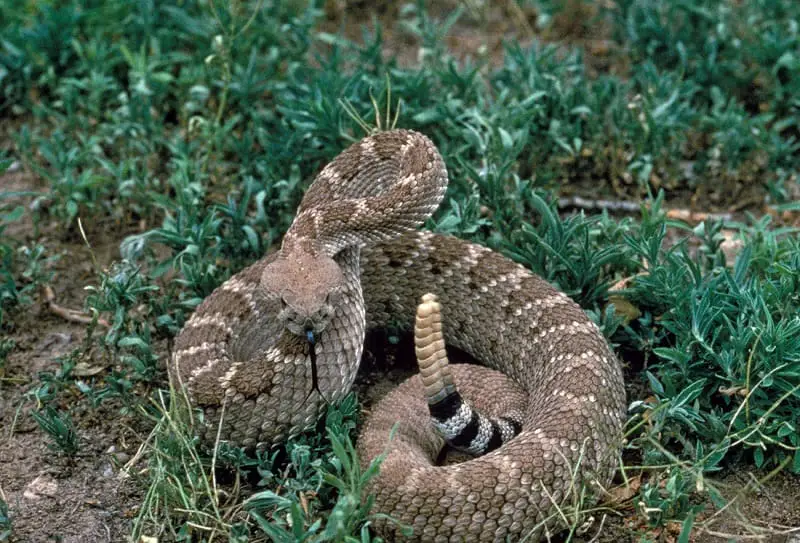
Western Diamondback Rattlesnake (Crotalus atrox)
This species has various names, including the Western Diamond-backed Rattlesnake and Adobe Snake.
What Do Western Diamondback Rattlesnakes Look Like?
| Size | Grows from 4 ft to 7 ft (1.22 to 2.13 m) in length. Average weight: 3 to 6 lb (1.23 to 2.7 kg) |
| Coloration | *Base colors: Yellow, light brown, salmon, gray, gray-brown, cream, or olive. *Dark diamond-shaped patterns along the back give it the name “Diamondback.” *A dark line runs from the corner of the mouth to behind the eye. |
| Dorsal spots | *Edges are darker than the base color. *Centers are slightly darker than the base color. |
| Head | *Features two to eight black bands above the rattle separated by pale gray bands. |
| Tail | *Features two to eight black bands above the rattle which are separated by pale gray bands. |
| Conservation Status | Common within their range. |
Where Do Western Diamondback Rattlesnakes Live in New Mexico?
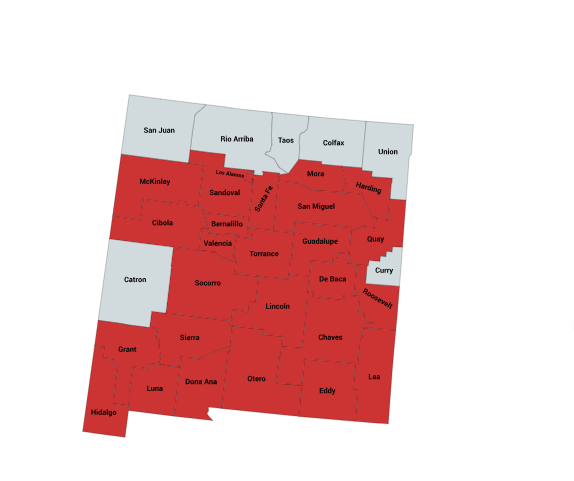
Western Diamondback Rattlesnakes are found throughout New Mexico. Their habitats include rocky canyons, plains, deserts, desert grasslands, and forests. They are the most commonly sighted rattlesnakes throughout the state. They’re also the largest of all the rattlesnakes found in New Mexico.
How Dangerous are Western Diamondback Rattlesnakes?
Western Diamondback Rattlesnake venom is Hemotoxic, cytotoxic, and myotoxic. If a Western Diamondback bite goes untreated, it can cause serious problems. These include severe internal bleeding and tissue damage, which might result in gangrene.
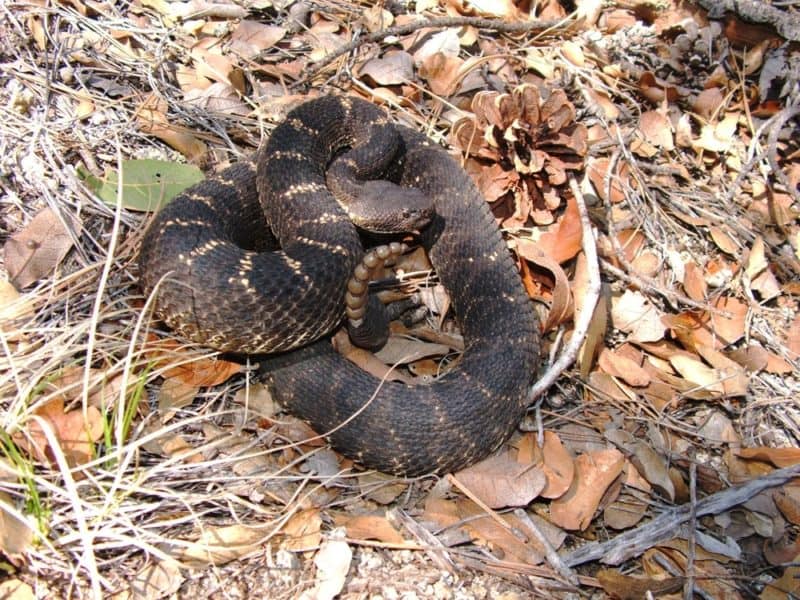
Arizona Black Rattlesnake (Crotalus cerberus)
This species has various common names. They include Black rattlesnake, Black Diamond rattlesnake, and Mountain Diamondback.
What Do Arizona Black Rattlesnakes Look Like?
| Size | *The Arizona Black Rattlesnake is a thick-bodied snake. *Adults typically range from 28 to 48 inches (70 to 121 cm) in length. |
| Coloration | *The base color varies and can be dark gray, reddish brown, or completely black. |
| Dorsal Spots | *Dark blotches run along the back, transitioning into crossbands near the tail. *In some individuals, the dorsal blotches may be darker and outlined with white, cream, or yellow scales. *Alternatively, the snake may appear uniformly dark with no distinct pattern. *Juveniles have more vivid and prominent markings compared to adults. |
| Unique Trait | *This species has a chameleon-like ability to change color, adapting to different surroundings. |
| Conservation Status | *Their range in New Mexico is limited, but they are common within their range. |
Where Do Arizona Black Rattlesnakes Live in New Mexico?
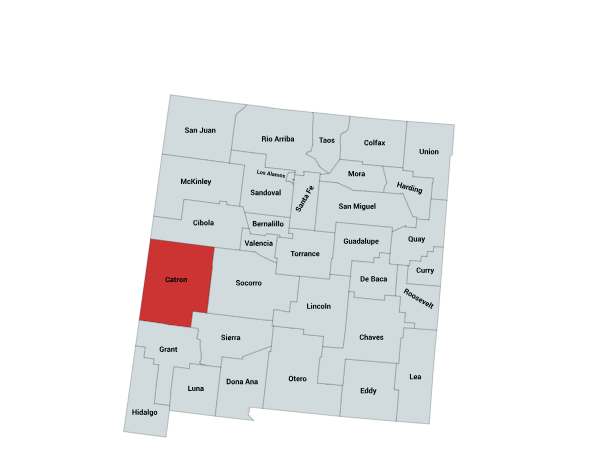
Arizona Black Rattlesnakes live in western New Mexico in Catron County.
These snakes prefer semi-desert grasslands, chaparral, coniferous woodlands, and montane conifer forests. They typically inhabit rocky drainages containing permanent or semi-permanent water.
How Dangerous Are Arizona Black Rattlesnakes?
Arizona Black rattlesnake venom is a mix of myotoxins and hemotoxins. Envenomations from this snake are rare. However, severe envenomation can produce pain, edema, blistering, nausea, and vomiting. The venom may also prevent blood coagulation and destroy red blood cells. This can produce shock and internal organ failure, particularly kidney failure.
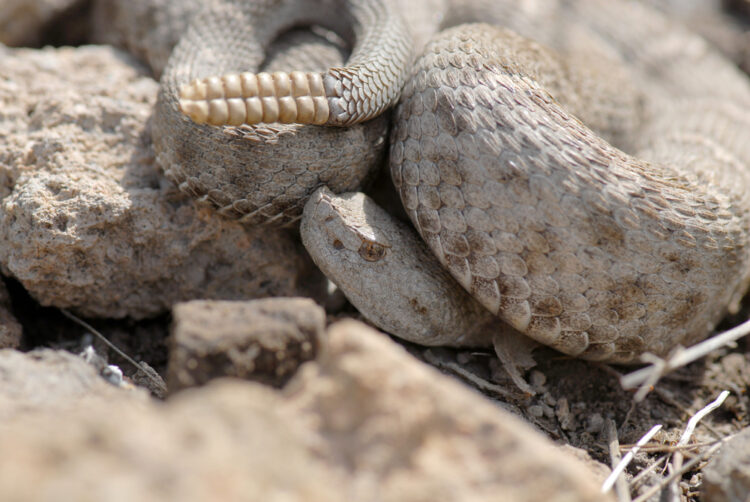
Animas Ridgenose Rattlesnake (Crotalus willardi obscurus)
Animas Ridgenose rattlesnakes are also called Ridge-nosed rattlesnakes.
What Do Animas Ridgenose Rattlesnakes Look Like?
| Size | *Adults measure 12 to 24 inches (30 to 61 cm) in length. |
| Coloration | *An Animas Ridgenose rattlesnake’s base color varies but is generally tan with a greenish tinge. |
| Dorsal Spots | *Along their backs, they feature a distinctive dark brown diamond-like pattern. |
| Head | *Like all pitvipers, Animas Ridgenose Rattlesnakes have triangular-shaped heads. *A pale stripe extends from behind its eye on a diagonal past the end of its jaw. *Ridges along each side of its nose are unique to these snakes. |
| Conservation Status | *Listed as threatened in New Mexico. |
Where Do Animas Ridgenose Rattlesnakes Live in New Mexico?
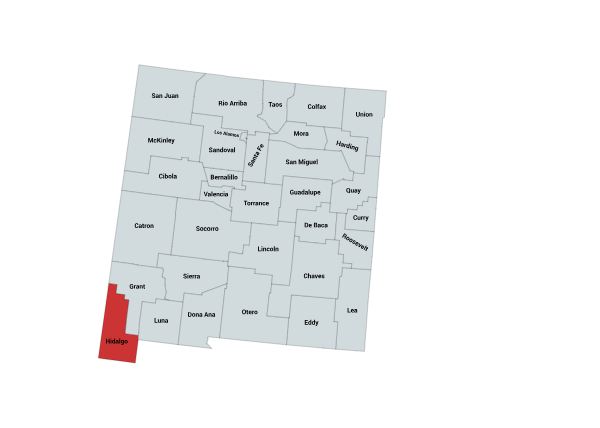
This species of rattlesnake lives in the Animas and Peloncillo Mountains. This is within the southwestern boot heel of New Mexico. They live in woodlands, grassy hillsides, and canyon bottoms. They are listed by the U.S. Fish and Wildlife Service as being threatened in the state.
How Dangerous are Animas Ridgenose Rattlesnakes?
These snakes have hemotoxic venom. Their venom yields are lower than that of other rattlesnakes, though. Consequentially, their bites are generally not life-threatening. In fact, there have been no documented deaths caused by their bite. But a bite from one of these snakes should still be taken seriously. The victim should still receive prompt medical treatment to be on the safe side.
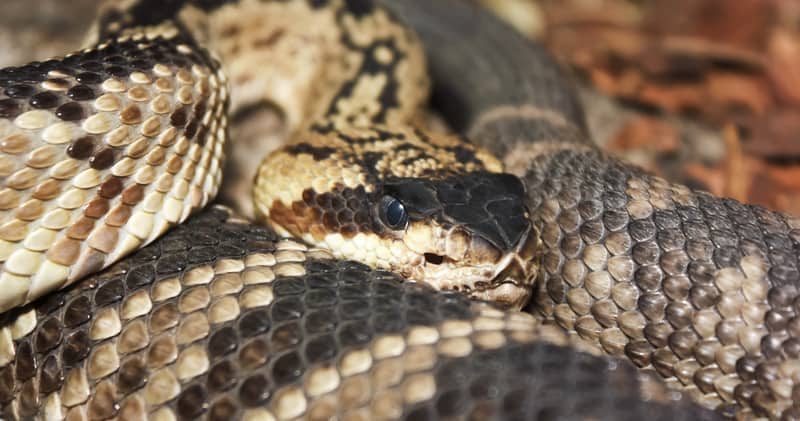
Mojave Rattlesnake (Crotalus scutulatus)
Other common names for this snake are Mojave Green Rattlesnake and Mohave Rattlesnake.
What Do Mojave Rattlesnakes Look Like?
| Size | *Adults range from 2 to 4 ft (about 0.61 to 1.22 m) in length. |
| Coloration | *A Mojave rattlesnake’s base color varies but is generally tan with a greenish tinge. |
| Dorsal Spots | *Along their backs, they feature a distinctive dark brown diamond-like pattern. |
| Head | *Like all pitvipers, Mojave Rattlesnakes have triangular-shaped heads. *The color varies with the base color of the snake. *A pale stripe extends from behind its eye on a diagonal past the end of its jaw. |
| Tail | *Tails are white and black banded. |
| Conservation Status | *The range of this snake is limited in New Mexico. However, they are common within their range. |
Where Do Mojave Rattlesnakes Live in New Mexico?
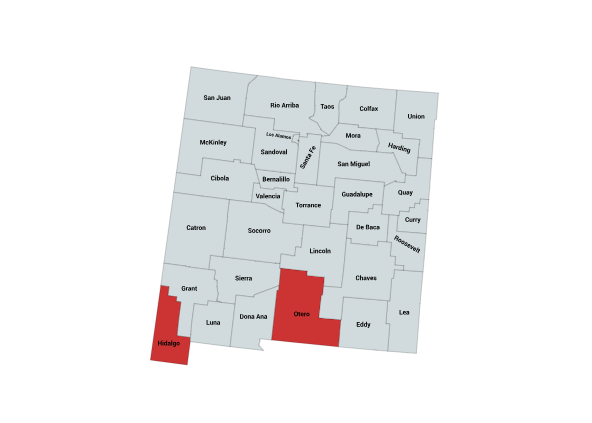
Mojave Rattlesnakes live in extreme southern New Mexico. They reside in both desert and grassland habitats. They prefer desert flats over areas with high volumes of vegetation or rocky areas.
How Dangerous Are Mojave Rattlesnakes?
Mojave rattlesnakes have highly potent venom. They are one of the most dangerous snakes in the United States.
Their venom is either hemorrhagic/hemotoxic or neurotoxic. The type of venom the snake has depends on the area in which it lives. Their hemorrhagic venom prevents blood clotting and destroys body tissue. On the other hand, their neurotoxic venom is even more dangerous. It shuts down the nervous system. Victims of neurotoxic venom may become paralyzed. Furthermore, they can lose the ability to breathe.
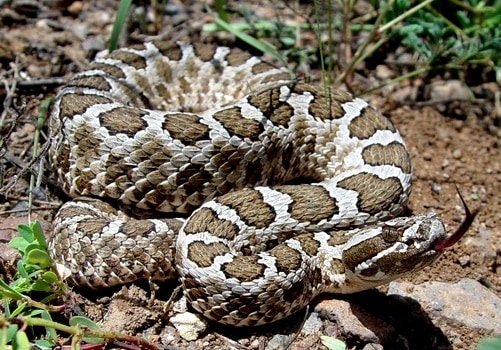
Desert Massasauga Rattlesnake (Sistrurus tergeminus edwardsii)
What Do Desert Massasauga Rattlesnakes Look Like?
| Size | *Adults range from 24 to 30 inches (61cm to 76cm) long. |
| Coloration | *Their base color is either tan or gray. *Younger snakes are paler than adults. |
| Dorsal Spots | *A row of large, rounded, blackish-brown spots run down their spine. *They have three smaller rows of spots down each side. *Sometimes, the more prominent dorsal spots connect with the side spots, forming a sizeable solid blotch. |
| Conservation Status | *No special status in New Mexico. |
Where Do Desert Massasauga Rattlesnakes Live in New Mexico?
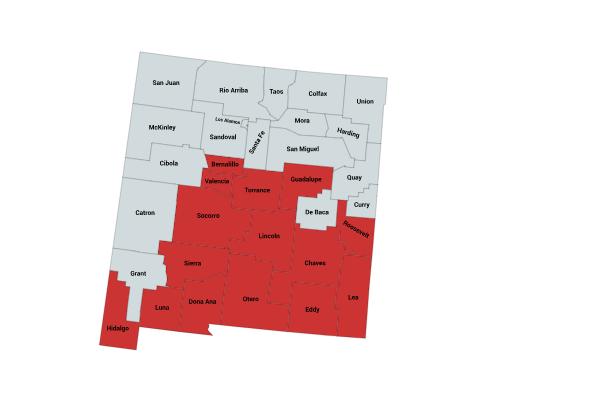
The Desert Massasauga is scattered across southern, central, and eastern New Mexico. They live in semi-desert grassland habitats.
How Dangerous are Desert Massasauga Rattlesnakes?
The venom of the Massasauga rattlesnake is cytotoxic. Cytotoxic venom destroys body tissue. Moreover, digestive enzymes in cytotoxic venom disrupt blood flow and prevent clotting. Massasauga bites to humans are rare. However, they do occur.
There are two documented deaths in Ontario from Eastern Massasauga envenomations. In each case, the victim did not receive antivenom in time.
Wild Cats In New Mexico – Krebs Creek
11 of the Most Dangerous Animals in New Mexico – Krebs Creek
12 Wild Berries in New Mexico – Krebs Creek
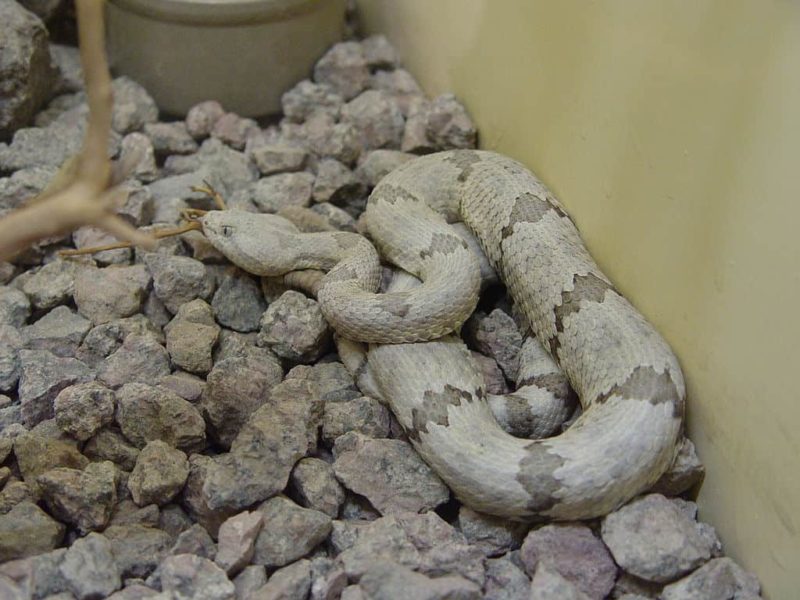
Mottled Rock Rattlesnake (Crotalus lepidus)
| Size | *The Mottled Rock Rattlesnake is a smaller snake that rarely exceeds 32 inches (81cm) in length. |
| Coloration | *Its color pattern varies with the color of the rock in its environment. *Specimens that are found in limestone areas are a light gray color. *Snakes found in higher altitudes are darker colored. |
| Markings | *Dark gray bands cover their body. |
| Conservation Status: | Threatened species within New Mexico. |
Where Do Mottled Rock Rattlesnakes Live in New Mexico?
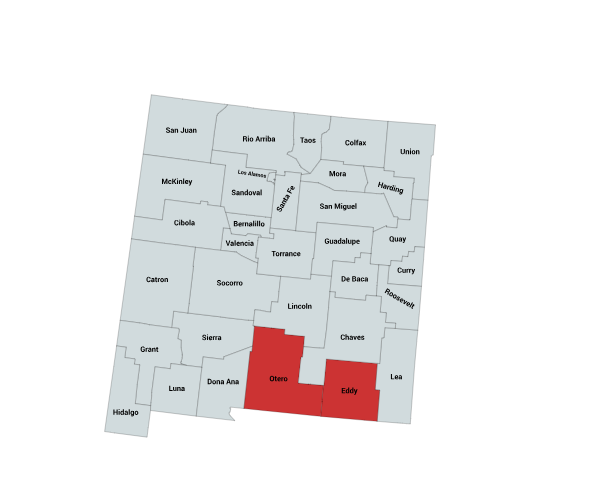
Mottled Rock Rattlesnakes inhabit isolated mountain ranges in Otero and Eddy Counties. This is in southern New Mexico.
How Dangerous Are Mottled Rock Rattlesnakes?
A Banded Rock rattlesnake’s venom is hemotoxic. It can lead to various symptoms. It can cause significant pain and swelling at the bite site, making it uncomfortable. Nausea and vomiting might also occur. It can affect blood clotting and lead to excessive bleeding. It may also induce shock, leaving the victim feeling weak and disoriented. There’s also a possibility of mild paralysis. It’s crucial to seek immediate medical help if bitten by a Banded Rock rattlesnake.
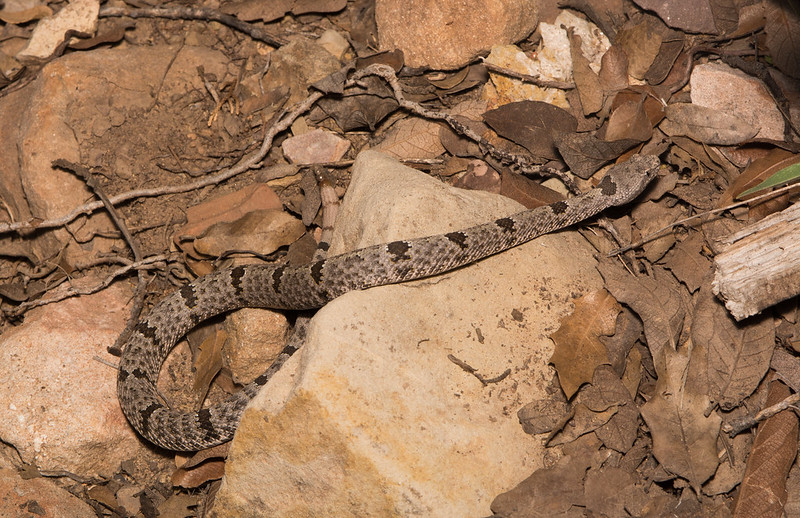
Banded Rock Rattlesnake (Crotalus lepidus klauberi)
What Do Banded Rock Rattlesnakes Look Like?
| Size | *These are smaller rattlesnakes, measuring 24 to 33 inches (61 to 84 cm) in length (excluding the rattle). |
| Coloration | *Their color pattern varies and ranges from bluish-gray to greenish-gray. *A pinkish mottling is sometimes visible on their underside, darkening toward the tail. |
| Dorsal Spots | *They have 14 to 24 dark gray to black jagged crossbands along their back. *Dark spots or flecks are often found between the crossbands. |
| Rattle | *Their rattle is large compared to their overall body size. |
| Conservation Status | A species of least concern in New Mexico |
Where Do Banded Rock Rattlesnakes Live in New Mexico?

Banded Rock Rattlesnakes inhabit the desert mountain ranges of southwestern New Mexico.
As its name implies, the Banded Rock rattlesnake spends time in rocky terrain. They prefer steep talus slopes, stream beds, and rock outcroppings in evergreen forests.
How Dangerous Are Banded Rock Rattlesnakes?
A Banded Rock rattlesnake’s venom is hemotoxic. It can lead to various symptoms. It can cause significant pain and swelling at the bite site, making it uncomfortable. Nausea and vomiting might also occur. It can affect blood clotting and lead to excessive bleeding. It may also induce shock, leaving the victim feeling weak and disoriented. There’s also a possibility of mild paralysis. It’s crucial to seek immediate medical help if bitten by a Banded Rock rattlesnake.
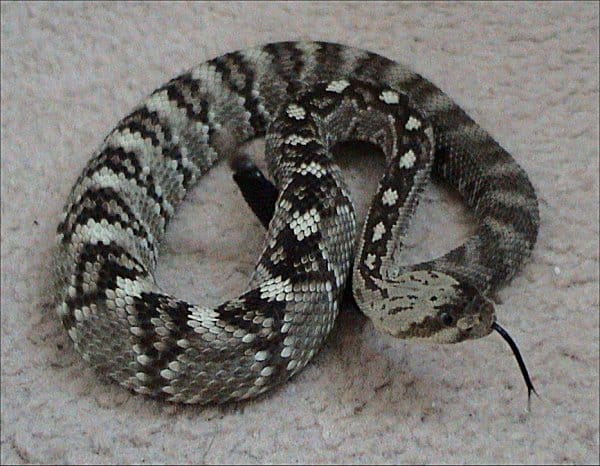
Northern Black-tailed Rattlesnake (Crotalus molossus molossus)
Northern Black-tailed Rattlesnakes are also sometimes called Western Black-tailed Rattlesnakes.
What Do Northern Blacktail Rattlesnakes Look Like?
| Size | *They measure 30 to 42 inches (76.2 to 106.48 cm) in length. *Males are generally smaller than females. |
| Coloration | *Their base color varies and can be yellow, olive green, or gray. |
| Dorsal Spots | *Dark blotches with white borders are present on their bodies. |
| Head | *A black “mask” band runs across their eyes, extending diagonally to the corners of their mouth. |
| Tail | *Their most distinctive feature is their black tail, which contrasts with their body color |
| Conservation Status | A species of least concern. |
Where Do Northern Black-tailed Rattlesnakes Live in New Mexico?
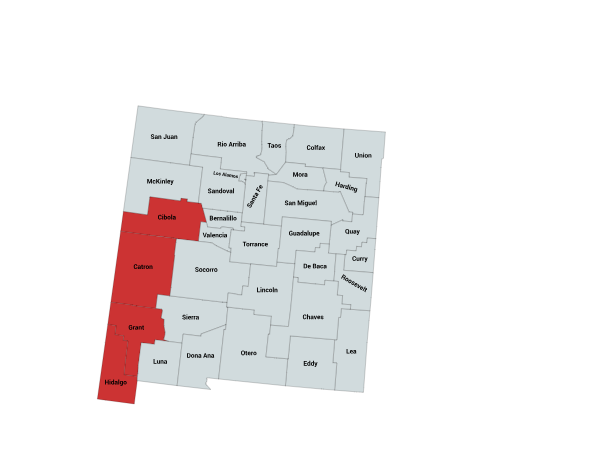
The Northern Black-tailed Rattlesnake is found within southwestern and central New Mexico. They live in rocky mountainous areas and occasionally in the low desert.
How Dangerous Are Northern Black-tailed Rattlesnakes?
The venom of the Northern Blacktail Rattlesnake is hemotoxic. However, it is less toxic than the venom of some other rattlesnakes. For example, it is only two-thirds as toxic as the venom of the Western Diamondback. In general, it is not fatal to humans. They have larger venom glands than most rattlesnakes in the area. Because their venom is less toxic, they must inject a large quantity into their prey to be effective.
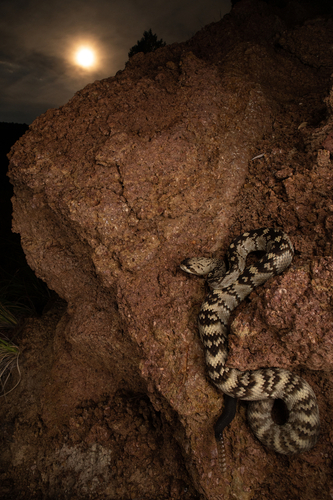
Eastern Black-tailed Rattlesnake (Crotalus ornatus)
What Do Northern Blacktail Rattlesnakes Look Like?
| Size | *Adults measure 22 to 48 inches (56 to 122 cm) in length. *Males are generally smaller than females. |
| Coloration | *Their base color varies and can be gray, brown, yellowish brown, or pale yellow. |
| Dorsal Spots | *Brown blotches with white borders are present on their bodies. |
| Head | *Large triangular head connected to a slender neck. *A black “mask” band runs across their eyes, extending diagonally to the corners of their mouth. |
| Tail | *Their most distinctive feature is their black tail, which contrasts with their body color |
| Conservation Status | A species of least concern. |
Their base color varies. It may be gray, brown, yellowish brown, or pale yellow.
They also have jagged eight-sided black or brown blotches across their backs. These blotches have white interior spots. Towards the back of the snake, these blotches lose their jagged edges. At this point, they become crossbands. As their name suggests, these snakes have solid black tails.
Eastern Black-Tailed Rattlesnakes look very similar to Northern Black-Tailed Rattlesnakes. A difference between them is that the anterior blotches are connected on the eastern. On the other hand, the blotches are separated on the northern.
Where Do Eastern Blacktail Rattlesnakes Live in New Mexico?
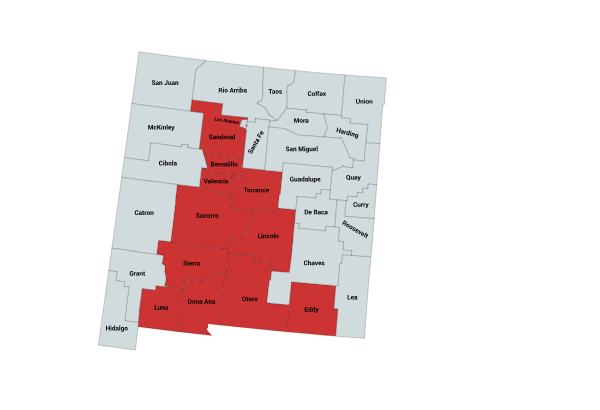
Eastern Blacktail Rattlesnakes range from south-central to north-central New Mexico. See the map for the counties that are included in their range.
How Dangerous Are Eastern Blacktail Rattlesnakes?
The venom of the Eastern Blacktail Rattlesnake is hemotoxic. However, it is less toxic than the venom of some other rattlesnakes. For example, it is only two-thirds as toxic as the venom of the Western Diamondback. In general, it is not fatal to humans. They have larger venom glands than most rattlesnakes in the area. Because their venom is less toxic, they need to inject a large quantity into their prey to be effective.

Prairie Rattlesnake (Crotalus viridis)
What Do Prairie Rattlesnakes Look Like?
| Size | *Adults typically measure about 3.3 feet (100 cm) in length. *The longest recorded specimen was just under 5 feet (151.5 cm) long. |
| Coloration | *Their base color varies and can be tan, olive green, or brown. |
| Dorsal Spots | *Brown blotches with darker borders are present on their bodies. |
| Head | *They have a triangular-shaped head with pit sensory organs on either side. *A light stripe runs diagonally from the back of each eye to the jaw. *Another stripe extends diagonally from below the eye to the corner of the mouth |
| Behavior | *Primarily ground-dwelling but occasionally climbs shrubs, bushes, or trees. |
| Conservation Status | Most common rattlesnake in New Mexico. |
Where Do Prairie Rattlesnakes Live in New Mexico?
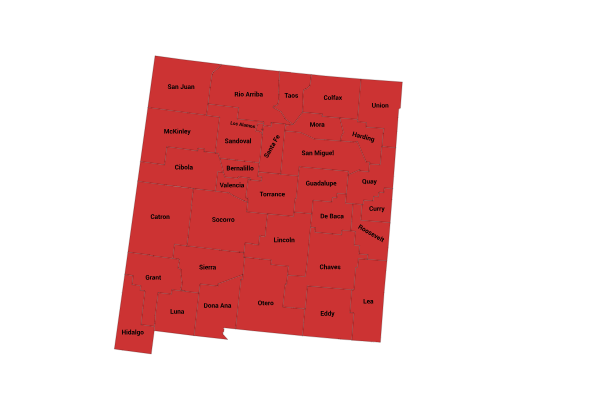
The Prairie Rattlesnake ranges throughout New Mexico. They live in grassland deserts and pine-oak forests.
How Dangerous Are Prairie Rattlesnakes?
Prairie rattlesnake venom is a mix of hemotoxins and myotoxins. Furthermore, according to some literature, it also has neurotoxins.
Prairie rattlesnake bites can have serious effects. The venom can cause severe pain. It may also induce shock, making the victim feel weak and disoriented. Swelling, blistering, and inflammation can occur at the bite site. Their venom can also damage red blood cells and impair blood clotting. In severe cases, the bite may result in severe tissue damage. There is also a risk of harm to internal organs.
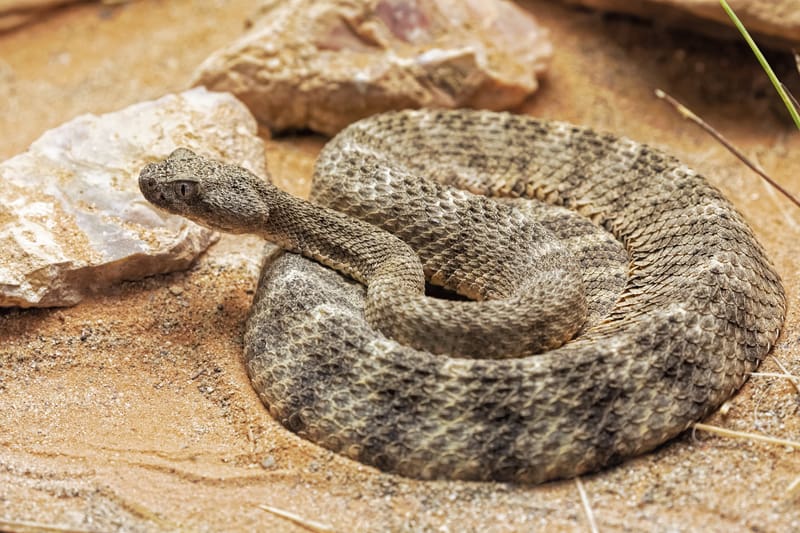
Tiger Rattlesnake (Crotalus tigris)
What Do Tiger Rattlesnakes Look Like?
| Size | *These snakes measure 18 to 36 inches (46 to 91 cm) in length. |
| Coloration | *Their base color varies and can be gray, blue-gray, lavender, pink, or buff. *Cream or pale orange tones are often visible on their sides. |
| Markings | *They have 35 to 52 brown or black crossbands that span their entire body. *Unlike most rattlesnakes, whose crossbands are confined to the tail, Tiger rattlesnakes are the only species with crossbands covering their entire body—this is a key distinguishing feature. |
| Head Shape | *Their head is small and spade-shaped, the smallest of all rattlesnake species. |
| Rattle | *They possess a disproportionately large rattle compared to their body size. |
| Conservation Status | A species of least concern. |
Where Do Tiger Rattlesnakes Live in New Mexico?
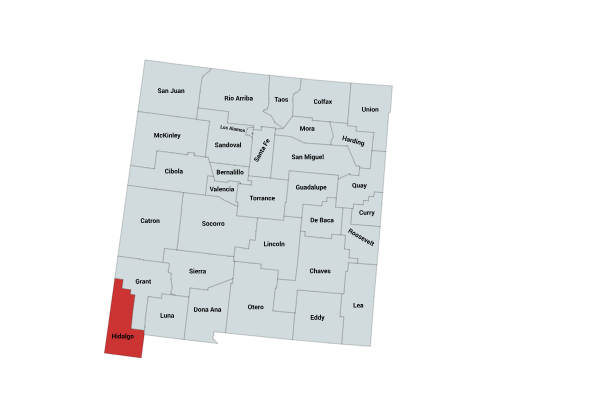
Tiger rattlesnakes live in southwestern New Mexico, specifically in Hidalgo County. They prefer rocky slopes and alluvial fan habitats. They tend to stay on steep slopes in the winter and early spring. However, they venture lower onto alluvial fans and into washes in the late spring and summer.
How Dangerous Are Tiger Rattlesnakes?
The Tiger rattlesnake has one of the deadliest rattlesnake venoms. It is a potent mix of hemotoxins and myotoxins.
This rattlesnake has a low venom yield per bite. But its venom has the second-highest toxicity of all the rattlesnake venoms. It is also the second most potent venom among all snakes in the Western Hemisphere.
There are a few recorded human envenomations by Tiger rattlesnakes. These all produced limited localized pain and swelling. These snakes produce a low venom yield and have small fangs. This possibly prevents adults from developing more severe reactions. However, a child or a smaller adult might have more severe complications. Any bite from a Tiger rattlesnake is a medical emergency. The bitten individual should seek immediate medical attention.
Coral Snake
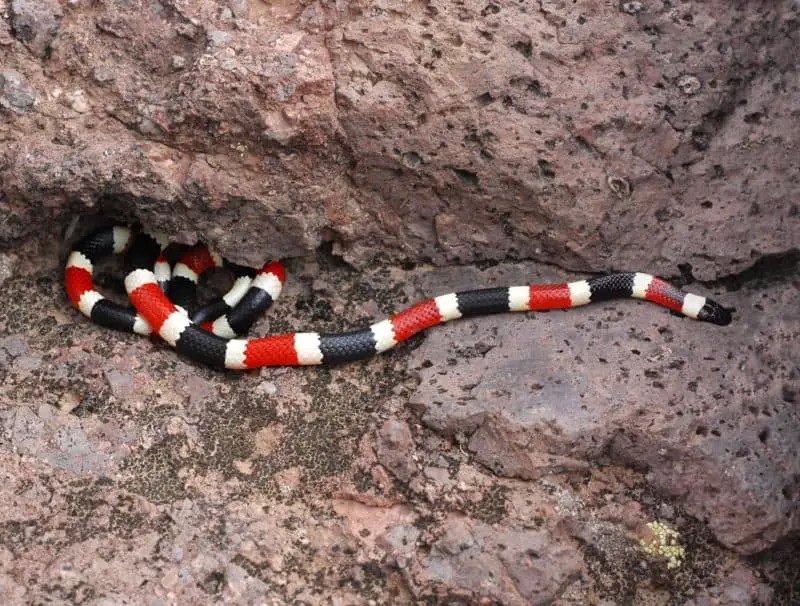
The Western Coral snake is New Mexico’s only venomous snake that is not a pit viper. Coral snakes belong to the Elapidae family. Other elapid snakes include cobras and sea snakes.
Western Coral Snake (Micruroides euryxanthus)
The Western Coral Snake is also called the Arizona Coral Snake or the Sonoran Coral Snake.
What Do Western Coral Snakes Look Like?
| Size | *Western Coral Snakes can grow 13 and 21 inches (33 and 53 cm) in length. *Sexually dimorphic: Males are slightly smaller than females. |
| Coloration | *Brightly colored, highly venomous snake. *Bands of black, light yellow, and red. *Yellow bands separate the red and black bands. |
| Physical Features | *Rounded heads and noses, with tails that resemble the head. *This similarity can make distinguishing the head from the tail hard. |
| Conservation Status | Common and not endangered within their range. |
Where Do Western Coral Snakes Live in New Mexico?
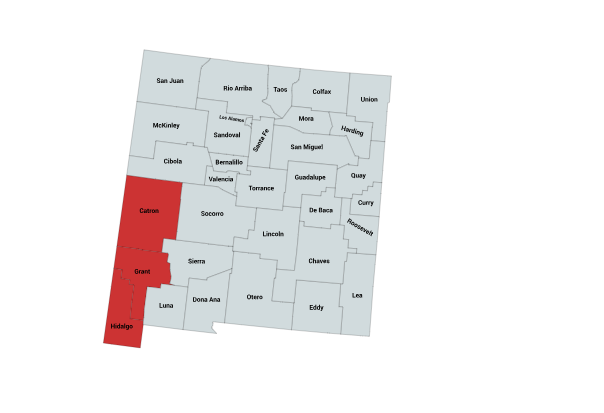
Coral snakes prefer habitat below 6000 feet in elevation. They inhabit plains, arroyos, and dry river bottoms. They also live on rock and mesquite-covered slopes. These snakes are found in southwestern Catron County. Further south, they also live in western Grant County and Hidalgo County.
Batesian Mimicry of Coral Snakes
Batesian mimicry is a biological term. It describes how a harmless species protects itself by resembling a dangerous one. For example, scarlet king snakes and milk snakes are non-venomous snakes. However, their color patterns closely resemble the venomous coral snake. The difference is that a coral snake’s red and yellow bands touch. On the other hand, the nonvenomous species’ color patterns are red, black, and yellow. Also, a coral snake’s head is blunt and entirely black, even behind its eyes, while a Kingsnake’s head is red.
This rhyme helps people distinguish between a nonvenomous species and a coral snake. “Red touch yellow can kill a fellow; Red touches black, a friend of Jack.”
The rhyme is mostly accurate in the United States. However, coral snakes from areas south of the U. S. do not always follow the black-yellow-red pattern. This is also true in Central America, South America, and the Caribbean.
Finally, rare coral snakes do not follow the usual color pattern in the United States. Pink, cream-colored, light blue and completely black coral snakes exist in the wild.
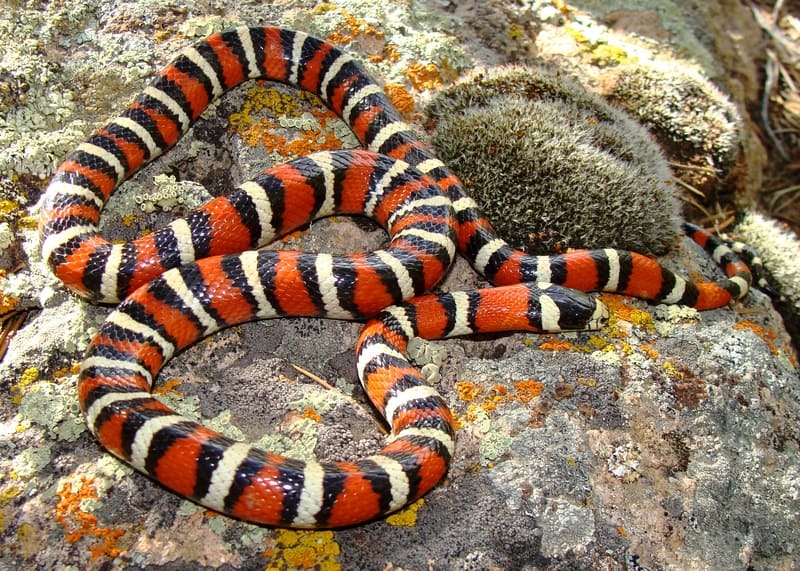

Western Coral Snake Behavior
Western Coral snakes are underground snakes. They spend most of their time buried in the sand, under leaf piles, and in rotten logs.
Defensive Farting
When rattlesnakes are uptight, they rattle their tails. On the other hand, coral snakes react to stress a bit differently.
When coral snakes are agitated, they fart. To do this, they draw air into their cloacas and force it out again. This makes a popping sound.
How Dangerous Are Western Coral Snakes?
Coral snakes are highly venomous snakes. Herpetologists regard them as the most venomous snakes in the United States. Fortunately, they almost never bite.
A coral snake’s venom is a neurotoxin and the second strongest snake. The experts consider coral snakes to be less dangerous than rattlesnakes, though. Their smaller mouths and short fangs produce less venom. Thus, they have a less effective venom delivery system.
People should take coral snake bites seriously, though. Before we had antivenom, the death rate after coral snake envenomation was around 10%.
Potential effects of coral snake envenomation include,
- muscle weakness
- difficulty speaking
- difficulty swallowing
- difficulty breathing
- Inability to move eyelids
- blurred vision
- twitching of the tongue
- paralysis
- respiratory arrest
One reported death has been caused by an Eastern Coral Snake bite in the last 40 years.
Avoiding Snake Bite
Snakes, including venomous ones, commonly rely on camouflage to avoid potential threats. They often remain perfectly still to avoid detection. If you’re walking in snake habitat and unknowingly get too close, a snake might not move, hoping you’ll pass by. Many bites happen when someone accidentally steps on or close to the snake. To stay safe in snake habitats, always watch where you step and where you place your hands.
Another common cause of snake bite is attempts to capture or kill a snake. Remember, venomous snakes can strike instantly, delivering a potentially life-threatening bite. The safest approach is to keep a safe distance and leave them alone.
Dressing for Snake Country
- High-top leather boots and long pants are both wise ideas.
- Also, wear loose-fitting denim. If there’s a gap before the snake’s fangs touch your skin, your chances of being envenomated are lower.
- In the absence of high-top leather boots, some people wear snake gaiters.
Symptoms of Venomous Snake Bites
Some of the symptoms you may experience from a venomous snake bite include:
- Discoloration in the area of the bite.
- Swelling in the area of the bite.
- Loss of muscle coordination.
- Tingling sensation in the area of the bite.
- Feeling nauseous.
- Having an abnormally rapid pulse.
What Should You Do If A Venomous Snake Bites You?
If you or someone you are with has suffered a venomous snakebite, time is of the essence. This is because the sooner a victim receives anti-venom, the less likely the venom in their body is to cause harm. In other words, it is essential to seek immediate medical attention.
Do not attempt to kill the snake for identification purposes. This gives the snake a chance to bite you again. Also, consider that severed snakeheads can still bite and envenomate. If you have a phone, take a picture of the offending reptile. Otherwise, get started on your way to the doctor.
First Aid for Snake Bite Victims
- Remain calm and limit your movements. Do not run. If you must hike back to a vehicle, do it calmly and deliberately. Put as little stress on your heart as possible.
- Keep the area of the snake bite below the heart level and never above the heart level. Keeping the bite below the heart level will reduce the venom’s flow. However, holding the bite above your heart level will increase the venom’s flow.
- Remove all constricting items such as bracelets, watches, or rings before swelling occurs.
- Remember that using a cold compress on a venomous snake bite is not advisable. The cold may cause the local blood vessels to constrict and spread the venom faster.
- You can wash the affected area like any other wound with soap and water.
- You may cover the bite area with a moist dressing to reduce the swelling.
- Get medical attention as soon as possible. Call the hospital to tell them a venomous snake has bitten you. So they can have anti-venom ready to give you as soon as you arrive.
- A person whom a venomous snake has bitten may go into shock. If this happens, you should lay them flat and cover them with a blanket.
Conclusion
The venomous snakes in New Mexico demand caution and respect. However, they’re more than just potential threats. They’re crucial in maintaining ecological balance because they control rodent populations. In turn, they keep populations of disease-carrying pests such as fleas and ticks in check.
Educating ourselves and others about these snakes gives us the tools to appreciate their role while avoiding the harm they represent as much as possible. By treating these creatures with respect and taking preventive measures, we can ensure our safety and the preservation of New Mexico’s unique wildlife heritage.
Recent Posts
The only venomous snakes in Washington State are Northern Pacific Rattlesnakes. The Northern Pacific Rattlesnake (Crotalus oreganus oreganus) is a sub-species of the Western Rattlesnake. Anyone...
Skunks are not classified as true hibernators. But they go into a state of torpor when the weather gets cold. Skunks are light sleep hibernators, along with opossums, bears, and raccoons. ...
